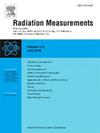Godiva-IV泄漏剂量特性
IF 2.2
3区 物理与天体物理
Q2 NUCLEAR SCIENCE & TECHNOLOGY
引用次数: 0
摘要
由于各自的机构正在培训新的核事故剂量计工作人员,因此需要进行核事故剂量计相互比较工作。这就需要一个中子和光子的参考剂量,供核事故剂量测定师测试他们的剂量计和分析。2014年,美国能源部(DOE)核临界安全计划(NCSP)支持了一项实验活动,以表征Godiva-IV泄漏剂量,以支持未来的演习。原子武器研究所(AWE)部署了一台被动邦纳球谱仪(PBSS)来测量中子能谱。用CaF2热释光剂量计(tld)测量光子剂量。结果记录在当时的一份报告中,但本文在此期间用其他测量结果重新分析和更新了这些结果。这项工作建立了更新的参考中子和光子剂量作为与Godiva-IV中心径向距离的函数,这将用于未来的NAD相互比较练习。本文章由计算机程序翻译,如有差异,请以英文原文为准。
Godiva-IV leakage dose characterization
As new nuclear accident dosimetrists are being trained by their respective institutions, there was a need for nuclear accident dosimeter (NAD) intercomparison exercises. This required a reference neutron and photon dose for nuclear accident dosimetrists to test their dosimeters and analysis. The U.S. Department of Energy (DOE) Nuclear Criticality Safety Program (NCSP) supported an experimental campaign to characterize the Godiva-IV leakage dose in 2014 to support future exercises. A Passive Bonner Sphere Spectrometer (PBSS) was deployed by Atomic Weapons Establishment (AWE) to measure the neutron spectrum. CaF thermoluminescent dosimeters (TLDs) were used to measure the photon doses. The results were documented in a report at that time but this paper reanalyzed and updated those results with other measurements in the interim. This work established updated reference neutron and photon doses as a function of radial distance from the center of Godiva-IV, which will be used for future NAD intercomparison exercises.
求助全文
通过发布文献求助,成功后即可免费获取论文全文。
去求助
来源期刊

Radiation Measurements
工程技术-核科学技术
CiteScore
4.10
自引率
20.00%
发文量
116
审稿时长
48 days
期刊介绍:
The journal seeks to publish papers that present advances in the following areas: spontaneous and stimulated luminescence (including scintillating materials, thermoluminescence, and optically stimulated luminescence); electron spin resonance of natural and synthetic materials; the physics, design and performance of radiation measurements (including computational modelling such as electronic transport simulations); the novel basic aspects of radiation measurement in medical physics. Studies of energy-transfer phenomena, track physics and microdosimetry are also of interest to the journal.
Applications relevant to the journal, particularly where they present novel detection techniques, novel analytical approaches or novel materials, include: personal dosimetry (including dosimetric quantities, active/electronic and passive monitoring techniques for photon, neutron and charged-particle exposures); environmental dosimetry (including methodological advances and predictive models related to radon, but generally excluding local survey results of radon where the main aim is to establish the radiation risk to populations); cosmic and high-energy radiation measurements (including dosimetry, space radiation effects, and single event upsets); dosimetry-based archaeological and Quaternary dating; dosimetry-based approaches to thermochronometry; accident and retrospective dosimetry (including activation detectors), and dosimetry and measurements related to medical applications.
 求助内容:
求助内容: 应助结果提醒方式:
应助结果提醒方式:


